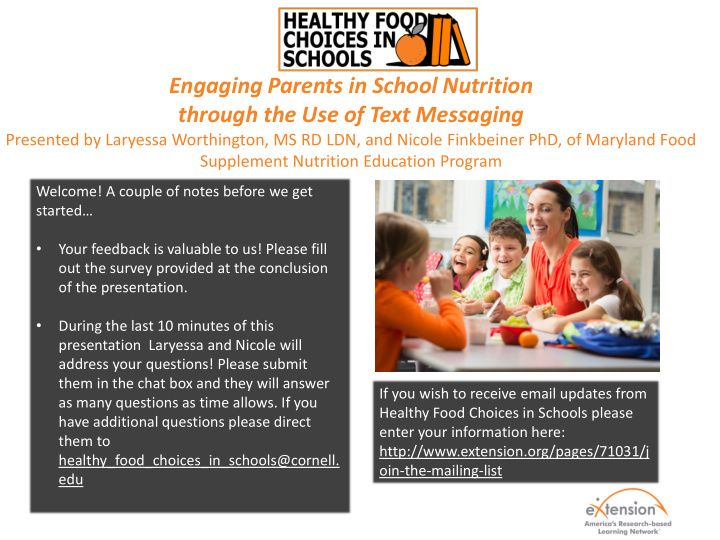



Engaging Parents in School Nutrition through the Use of Text Messaging Presented by Laryessa Worthington, MS RD LDN, and Nicole Finkbeiner PhD, of Maryland Food Supplement Nutrition Education Program Welcome! A couple of notes before we get started… • Your feedback is valuable to us! Please fill out the survey provided at the conclusion of the presentation. • During the last 10 minutes of this presentation Laryessa and Nicole will address your questions! Please submit them in the chat box and they will answer If you wish to receive email updates from as many questions as time allows. If you Healthy Food Choices in Schools please have additional questions please direct enter your information here: them to http://www.extension.org/pages/71031/j healthy_food_choices_in_schools@cornell. oin-the-mailing-list edu
Text2BHealthy : Engaging Parents in School Nutrition through the Use of Text Messaging Laryessa Worthington, MS RD Nicole Finkbeiner, PhD
Who Texts? • U.S. adults ‒ 90% own a cell phone (Pew, 2015) ‒ 64% have a smartphone ‒ 81% send/receive text messages • Lower income audiences (<$30,000 per year) (Pew, 2015) – 84% own a cell phone – 13% are smartphone-dependent • Racial and ethnic minorities (Pew, 2014) – 90% of Black and 92% of Latino persons use cell phones • Text messaging is the most widely-used smartphone feature among users (Pew, 2105)
Benefits of Text Messages • Access to a diverse audience (DHHS, 2013) – Hard-to-reach populations • Relatively low cost to researchers and participants (Fieldsoe et al., 2009) • Easily and quickly sent to a large audience • Perceived as personal and informal (Gold et al., 2010) • Easy to incorporate into everyday life – Remote (for researchers) – Instant & in context (for participants) – Reduce participant burden (Marshall et al., 2013) • Real-time, interactive evaluation
Social Ecological Model
Text2BHealthy • Reaches parents of elementary school children • 2 community-specific text messages per week • Purpose is to promote nutrition and physical activity, connect parents to school/community nutrition resources and events, and reinforce key messages taught in classroom-based nutrition education in the home. • Program objectives: – Increase fruit and vegetable consumption, – Increase the variety of fruits and vegetables consumed – Increase daily and weekly physical activity
Targeted Messages • Elementary schools can help us to know about…. – School activities – Breakfast and lunch menus – School schedules, testing, events – Lunch menus – Farm to school events – School gardens – Fruit and vegetable tasting in the cafeteria – Special events related to nutrition and physical activity ...without even knowing a parent’s name!
Sample Text Messages It's tropical fruit week! Did you know that Wash Grove Moravia kids tried papaya, has a school garden? This banana, & pineapple. Ask week 1st and 3rd graders will be them what they liked best! planting spring crops. Ask your child to see what veggie they planted! Fruit & veggie tastings School gardens It's homegrown school lunch week! Maryland grown spinach & tomatoes are served in the cafeteria tomorrow. Ask your child to try both & report back on the taste! Homegrown School Lunch Week
Program Recruitment • Flyers • Posters • In-person events • Website • Other school channels – Newsletters, robocalls, parent nights, etc.
Enrollment Numbers Participants Retained Schools Counties Y1 203 14% 91% 8 4+Baltimore City 2011-2012 Y2 1149 25% 90% 15 6+Baltimore City 2012-2013 Y3 2473 33% 90% 21 8+Baltimore City 2013-2014 Y4 2399 35% 99% 17 5+Baltimore City 2014-2015 *Current year (Year 5) – 2,307 enrolled to date (16 schools)
Program Evaluation • Pre-then-post survey • Texted questions • Focus groups • Non-intervention/control schools
Healthy Families Survey • Pre-then-post tool (September and May) • Mailed/online surveys • Eating behaviors, physical activity behaviors, food availability/ accessibility, role modeling
Outcomes: Daily Fruit & Vegetable Consumption
Outcomes: Snacking Behaviors
Outcomes: Fruit & Vegetable Consumption and Availability • Before Text2BHealthy , 44% of parents reported that their child ate more than 1 type of vegetable per day on most or all days, whereas 53% of parents reported the same after Text2BHealthy . • Parents who often or always talk about the fruits and vegetables children eat at school increased from 45% to 51%. • Parents who keep vegetables ready for their children to eat most or all days increased from 70% to 79%. • Parents who keep fruit ready for their children to eat most or all days increased from 81% to 87%.
Program Barriers/Challenges • 26% of non-participants reported not knowing how to enroll or having unsuccessful attempts at enrollment • Concern about cost of texting • Accommodating those without a texting plan • Apprehensive about program content • Disabled short codes • Knowledge of how to send a message to someone not in address book • Enrollment of non-targeted individuals * Consider drop-outs
Recommendations for Implementation • Seek substantial buy-in from partners – Can help reach audience, promote and incentivize enrollment, and connect program to other activities • In-person enrollment is critical! – Offer to collect mobile phone numbers and manage enrollment for parents; have alternatives • Test materials and messages via focus groups – Widespread use of cell phones (smartphones in particular) and text messaging – Suggestions for appropriate messages (no textisms, personalized) – Preferences for timing of messages
Final Notes • Targeted and incentivized evaluation strategies work! • Be flexible – be open to modifying your processes and ALWAYS learn from previous experiences! • Consider the many different ways that you can link parents to healthier school choices • Text messaging offers the ability to add a policy, systems, and environmental (PSE) component to your school-based nutrition efforts
Contact information: Laryessa Worthington lengland@umd.edu Nicole Finkbeiner nicole4@umd.edu
Thank you for attending! We hope you found the presentation informative and useful! Your feedback is important to us! Please help us evaluate our efforts by filling out this survey: https://vte.co1.qualtrics.com/SE/?SID=SV_1NWlmFNcd9wl9s1 A recording of this webinar will be available shortly at: https://learn.extension.org/events/2568 To learn more about Healthy Food Choices in Schools please contact: healthy_food_choices_in_schools@cornell.edu
Recommend
More recommend